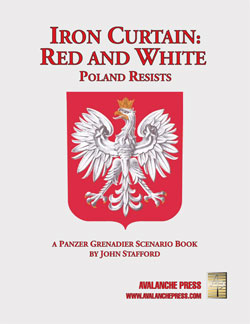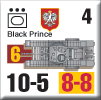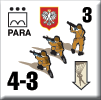| Red and White:
Publisher's Preview
By Mike Bennighof, Ph.D.
August 2014
 Iron Curtain: Red & White is the third installment in our series of Panzer Grenadier settings books, looking at the ramifications of a Cold War turned hot in 1950 and 1951. Iron Curtain: Patton’s Nightmare looked at this question from the American point of view, and Iron Curtain: Hammer & Sickle from the Soviet point of view. And now Iron Curtain: Red & White takes up the Polish point of view. Iron Curtain: Red & White is the third installment in our series of Panzer Grenadier settings books, looking at the ramifications of a Cold War turned hot in 1950 and 1951. Iron Curtain: Patton’s Nightmare looked at this question from the American point of view, and Iron Curtain: Hammer & Sickle from the Soviet point of view. And now Iron Curtain: Red & White takes up the Polish point of view.
While that may not seem like a logical progression (no British?), it’s in keeping with the pattern of the first two books, making use of our stockpiles of playing pieces for discontinued comb-bound booklets. Some years ago we published a comb-bound set of scenarios called Polish Steel, with 77 very nice die-cut pieces. It didn’t sell very well, and I eventually realized this was in part because it had no context. We did not develop the setting, a crucial concept in the world of role-playing games from which we borrowed our core-plus-supplements publishing model for Panzer Grenadier. That was true for the old Iron Curtain comb-bound booklet as well, so some time back I set John Stafford the task of correcting these deep flaws.
What he’s come up with is, to my mind at least, simply brilliant. It’s not exactly what I had in mind, but it’s outstanding work all the same (or maybe because of that). Each of the three Iron Curtain books takes a slightly different look at how the Cold War might have turned hot, and takes off from there. The bare outlines of the conflict are the same, but they proceed very differently from that start.
 Red & White takes the pieces from the old Polish Steel, but otherwise John threw everything away and started from scratch. The setting places the Poles at home in a free and democratic Poland surrounded by the Soviet Union and Communist puppet states. The Poles are staunchly anti-communist, to the point of fraying that whole “free and democratic” banner, and tensions are high from the start. By late 1951 they explode into open warfare, with Soviet armies invading independent Poland against staunch Polish resistance, with American and French armies landing at Poland’s Baltic ports to help repel the invaders. Red & White takes the pieces from the old Polish Steel, but otherwise John threw everything away and started from scratch. The setting places the Poles at home in a free and democratic Poland surrounded by the Soviet Union and Communist puppet states. The Poles are staunchly anti-communist, to the point of fraying that whole “free and democratic” banner, and tensions are high from the start. By late 1951 they explode into open warfare, with Soviet armies invading independent Poland against staunch Polish resistance, with American and French armies landing at Poland’s Baltic ports to help repel the invaders.
The Poles have many modern weapons supplied by the Americans and British: Centurion, Black Prince, Chaffee and Pershing tanks, 17-pounder anti-tank guns, M3 halftracks and Hoverfly helicopters. And even a little bit of liberated German heavy metal, plus Polish paratroopers. They’re going to need every bit of firepower they can muster, with the Soviets throwing all of the powerful weapons from Hammer & Sickle at them: JS3 and JS4 heavy tanks, AK-toting infantry, T44 medium tanks and the Su101 heavy assault gun. Plus the merely awesome weaponry from Road to Berlin like the JS2 heavy tank and the T34/85 medium tank. Polish units are tough and well led, assumed to have a hard core of veterans from both the Polish Exile corps fighting in the West and the Soviet-sponsored Polish armies fighting in the east a few years earlier, plus new young recruits determined to never again allow foreign domination of Poland.
 The pieces themselves are die-cut, not laser-cut, but they’re from the last batch we ever did of die-cut ones and they’re a pretty nice example of the type. The die-strike damage is pretty mild, and they’re much thicker than the usual die-cut piece. They sport the usual Polish white color scheme, with of course the White Eagle emblem. The pieces themselves are die-cut, not laser-cut, but they’re from the last batch we ever did of die-cut ones and they’re a pretty nice example of the type. The die-strike damage is pretty mild, and they’re much thicker than the usual die-cut piece. They sport the usual Polish white color scheme, with of course the White Eagle emblem.
The book is a little different from its two sisters: there’s no campaign game this time. Those are really hard to craft and player feedback seems to show they’re not played nearly as much as the stand-alone scenarios. So this time John went with only stand-along scenarios to tell his story: forty of them. They do a good job of following the action as the Soviets push into Poland from all sides and the Poles defend their land with their usual passion, and eventually with American help, too.
 When we first started offering Panzer Grenadier campaigns I was excited by the concept, and as a game designer looked forward to writing a few of my own. I started one and quickly found out that it takes an enormous amount of work, a lot more than it looks. If they’re not being played, we’re doing everyone a better service by concentrating on the stand-alone scenarios – twice as many brand-new scenarios as its two sisters feature. When we first started offering Panzer Grenadier campaigns I was excited by the concept, and as a game designer looked forward to writing a few of my own. I started one and quickly found out that it takes an enormous amount of work, a lot more than it looks. If they’re not being played, we’re doing everyone a better service by concentrating on the stand-alone scenarios – twice as many brand-new scenarios as its two sisters feature.
After a good bit of thought, I think I understand why the campaigns aren’t that popular: because of its scale, and because of the nature of World War II (including early-Cold-War-turned-hot) tactical combat, there are plenty of interesting battles to make into scenarios. It’s an endless supply, even with our penchant for scenario books the size of Aunt Minnie’s Sunday hymnal. Unlike the naval games, there’s no real call for a tactical scenario generator.
 So we’ve gone instead with what we know players like: scenarios and lots of them. There are some really large scenarios in here, with eight maps and scads of units. There are big tank battles, and a few small infantry fights. And then there are the strange scenarios that John Stafford loves, like an American raid on a Soviet airbase and a Polish attempt to overrun Soviet supply dumps. When you have 40 of them, you can get a little weird. So we’ve gone instead with what we know players like: scenarios and lots of them. There are some really large scenarios in here, with eight maps and scads of units. There are big tank battles, and a few small infantry fights. And then there are the strange scenarios that John Stafford loves, like an American raid on a Soviet airbase and a Polish attempt to overrun Soviet supply dumps. When you have 40 of them, you can get a little weird.
I’ve been really pleased with Red&White since I first laid eyes on it: it came in before its deadline, and it came in almost exactly at the prescribed length. It went smoothly through editing. It’s the work of a true professional as rarely seen in the game business, and I think you’ll really appreciate those nice touches, too.
Don’t wait to put Iron Curtain: Red & White on your game table! Join the Gold Club and find out how to get it before anyone else!
Mike Bennighof is president of Avalanche Press and holds a doctorate in history from Emory University. A Fulbright Scholar and award-winning journalist, he has published over 100 books, games and articles on historical subjects.
He lives in Birmingham, Alabama with his wife, three children and his dog, Leopold.
|
